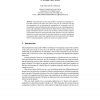Free Online Productivity Tools
i2Speak
i2Symbol
i2OCR
iTex2Img
iWeb2Print
iWeb2Shot
i2Type
iPdf2Split
iPdf2Merge
i2Bopomofo
i2Arabic
i2Style
i2Image
i2PDF
iLatex2Rtf
Sci2ools
DSVIS
1998
Springer
1998
Springer
Inference and Information Resources: A Design Case Study
Abstract. Much attention has been paid in HCI to techniques for designing systems that conform to the tasks users wish to carry out. It is often the case that such approaches rely on identifying the combinations of commands a user will be expectedto issue and information thay will need to access,and designingan interface with appropriate temporal behaviour. Many fields of activity, however, are highly information intensive, and the way in which a human-machine cognitive system makes inferences and reasons and makes decisions is far more important that the way it carries out actions. In this paper, therefore, we explore an approach to design that places much more emphasis on the form and structure of a display than it's temporal properties, and the role it plays in cognitive activity.
Appropriate Temporal Behaviour | Computer Human Interaction | DSVIS 1998 | Much Attention | Tasks Users |
| Added | 05 Aug 2010 |
| Updated | 05 Aug 2010 |
| Type | Conference |
| Year | 1998 |
| Where | DSVIS |
| Authors | Robert E. Fields, Nicholas A. Merriam |
Comments (0)

